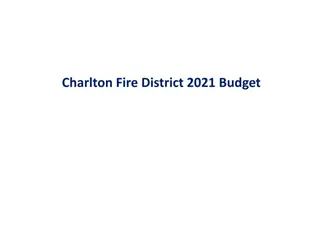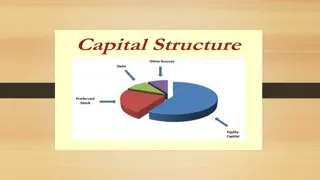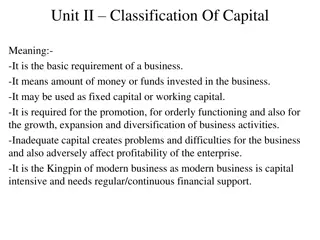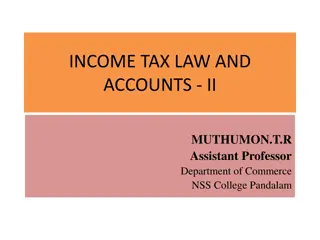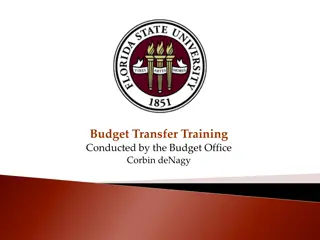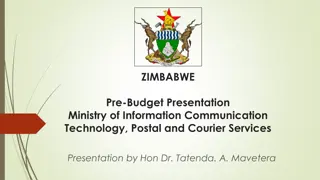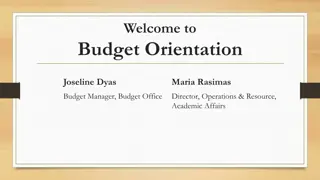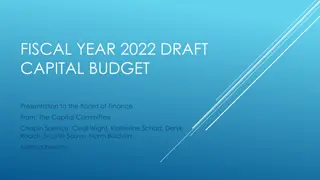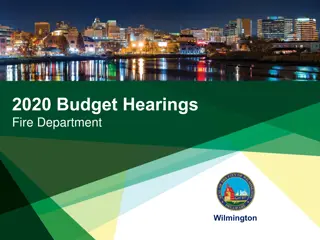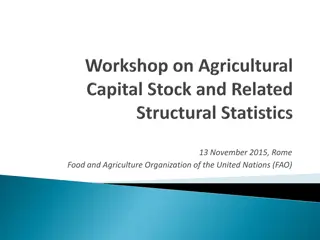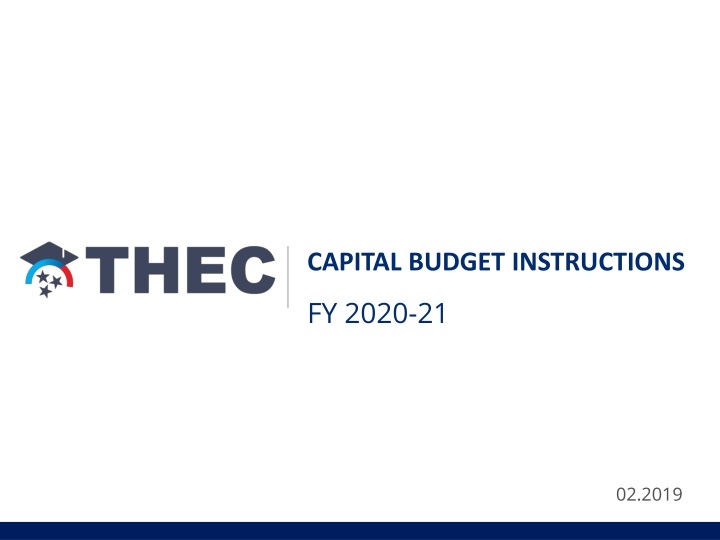
Streamlined Instructions for FY2020-21 Capital Budget Submissions
Streamlining the capital budget instructions for FY2020-21 involves standardizing requested data, reducing narrative lengths, and eliminating data duplication. Projects aligning with state goals, impacting degree production or research/workforce development, exhibiting detailed planning, and showcasing qualitative and quantitative facility needs are more competitive. Submission requirements for previous projects remain, emphasizing competitiveness in scoring. Primary assessment categories, maintenance instructions, and documentation requirements remain similar from FY2019-20. Noteworthy changes for FY2020-21 include all documents being in an Excel workbook format, a more detailed project summary sheet upfront, and narrative sections now broken down into specific questions within the workbook to enhance information clarity.
Uploaded on | 0 Views
Download Presentation

Please find below an Image/Link to download the presentation.
The content on the website is provided AS IS for your information and personal use only. It may not be sold, licensed, or shared on other websites without obtaining consent from the author. If you encounter any issues during the download, it is possible that the publisher has removed the file from their server.
You are allowed to download the files provided on this website for personal or commercial use, subject to the condition that they are used lawfully. All files are the property of their respective owners.
The content on the website is provided AS IS for your information and personal use only. It may not be sold, licensed, or shared on other websites without obtaining consent from the author.
E N D
Presentation Transcript
CAPITAL BUDGET INSTRUCTIONS FY 2020-21 02.2019
Introduction Review and approval by respective President s and Governing Boards Spring, 2019 Due date for UT, TBR and 6 LGI s capital budget submittals to THEC: July 1, 2019 Projects evaluated and scored, presented to THEC for action at November 7, 2019 meeting Projects are evaluated by Governor as part of State Budget process, presented at State of the State January, 2020. Final approval of projects funding and State FY2020-21 budget is by the State Legislature, late spring, 2020. 2
Introduction Streamline instructions: standardize requested data, reduce narrative lengths, eliminate duplication in data Projects that are most consistent with state goals, have greater impact on degree production or enhancing research/workforce development, are well planned (academic and facility planning), and demonstrate qualitative and quantitative need for the facility are most competitive. Is the project specifically identified in the Master Plan? Level of program and project development 3
Introduction All project submittals must follow the FY2020- 21 instructions including previously submitted projects. Must resubmit projects if they are not funded this year. Projects that are previously recommended are not guaranteed recommendation the following year. Scoring is very competitive. 4
Remains the Same from FY2019-20 to FY2020-21: 5 Primary categories for assessment Match/External Funding requirements DB70 and Support Documentation, Movable Equipment Description of Facilities Condition moved to Support Documentation Space Needs, Tabulation of Affected Space, Funding Analysis (now called External Funding) with minor adjustments Maintenance Instructions Disclosure Instructions 5
Changes for FY2020-21 All documents are now in the excel workbook. There is a project summary sheet in the front of the workbook. Sections I (State Goals and Drive to 55) and II (Campus Master Plan) continue to be narrative formats, but are broken down into defined questions. Allows specific points to be assigned to more specific subjects in the narrative Assists SPA in defining the information THEC is requesting Placed narrative Sections 1 and 2 into the excel workbook to keep all information in one place Enrollment Data sheet placed in spreadsheet in Section 1; example included in instructions. 6
Changes for FY2020-21 Business Plan narrative: Previously called First-Year Operating Costs Overview of the financial plan associated with the operations Summarize the annual net additional costs for programs, staffing, operations, utilities and maintenance costs Financial efficiencies achieved with the project Does this project represent a new replacement building that is no more than 10% more square feet than a building proposed to be demolished? Revenue Sources, Fundraising and Partnerships: Fundraising campaign or other community/industry partners that will be specifically associated with this project Revenue sources expected to defray additional ongoing costs 7
Changes for FY2020-21 An appendix is provided for supplemental information. Required Appendix Documents: Institutional Mission Profile (Not required for TCAT s) THEC Space Allocation Guideline workbook (completed) Applicable Facilities Survey Summary Sheets (PFIS) Supplemental Support Documents, such as master plan drawings, plans and concept drawings An architectural program is required. 8
Introduction THEC Review Process Project are evaluated on basis of materials submitted, and response to written instructions. THEC reserves right to visit campus to review the project with campus constituents prior to final scoring, but not required. Review team consists of cross-discipline THEC staff and advisors. Letters of support will not be reviewed. Strive to have fair and consistent review process based on both qualitative and quantitative elements, addressing balance of academic and facility needs 9
Submittal Requirements Seven (7) hardcopies of Outlay, Two (2) hardcopies of Maintenance and Disclosure Projects Email, jump drive, and deliver all hardcopy documents by July 1, 2019. Please refer to project naming formats for electronic files. Department of Finance & Administration Requirements o Additional materials from SPA s will be required by end of September, 2019, date to be confirmed (data entry into F&A Access) o Four (4) USB flash drives with all completed DB70 forms and data 10
Capital Outlay Out-Years List in order of priority; priority may be modified from year-to-year. UT and TBR do not need to include banded projects. List estimated total project cost and source of funds o Total costs include hard construction costs, construction contingencies, soft costs such as feeds, FFE, AV equipment, owner testing, programming if required, commissioning, IT equipment/infrastructure if purchased separately, administrative costs. o Total costs listed in inflated projected costs as though funded in Budget Year 2020-21. 11
5 Criteria All Prioritization Criteria 1. State Goals & the Drive to 55 2. Strategic Plan and Campus Master Plan 3. Project Description and Impact on Campus 4. Space Needs 5. External Funding Universities, CC, and Nonformula Units TCATS 22 28 18 18 28 24 8 28 26 0 100 TOTAL 100 12
1. State Goals and Drive to 55 4 pages in workbook, 1.1, 1.2, 1.3, 1.4 Capital projects are linked to state goals and the Drive to 55, including: Increasing degree production, particularly at the undergraduate level; Enhancing research and/or workforce development; Emphasizing focus populations, as identified in the outcomes-based funding formula; and Identifying and addressing education and workforce needs of local and regional economies. 13
1. State Goals and Drive to 55 THEC 2015-2025 Master Plan The overriding function of the Plan is to direct higher education to be accountable for increasing the educational attainment levels of Tennesseans, while also: addressing the state s economic development, workforce development, and research needs. Although this Plan places certificate training and undergraduate education at the center of the state s college completion policy agenda for the decade 2015-2025, the state continues to acknowledge the critical need for academic programs of distinction at the graduate and professional level to fully address Tennessee s economic development, workforce, and research needs. 14
2. Campus Master Plan and Project Development 2.1 A - Master Plan Project Description, Goals, Links to Master Plan 2.1 B - Master Plan Priority 2.1 C - Master Plan Space Needs and Facility Conditions 2.2. D - Project Development since Master Plan 2.2 E - Architectural Program and Planning, Status, Progress (Full Program Required Y/N) 2.2 F - Alternatives Considered to Meet Objective 15
3. Project Description and Impact on Campus Provides an overview of the project, Confirmation of the Governing Board s understanding of the project, and Confirms the level of pre-planning conducted in advance of the submittal. DB70 family of sheets, modified 16
3. Project Description and Impact on Campus 3.1 DB70 Form Project Request 3.2 Project Support Documentation -1 3.3 Project Support Documentation 2 3.4 Schedule of Movable Equipment 3.5 Business Plan (Previously First- Year Operating Costs ) oOperations Overview oRevenue Sources, Fundraising and Partnerships Eliminated: Bond Questionnaire 17
3. Project Description and Impact on Campus Project Support Doc 1 3.2 A - Program Scope Describe the scope of work included in the project 3.2 B - Evidence of Physical Facility Need Describe deficiency being remedied by the project, whether lack of space for growing demand, poor repair, etc. 3.2 C - Historical Profile Related history of the facility and program. For existing structures, specify dates of construction, additions and renovations, etc. 3.2 D - Summary Results and Date of Physical Facilities Survey 19
3. Project Description and Impact on Campus Project Support Doc 2 3.3 E - Cost Information Basis for SF cost estimates, support for construction cost and methods for determining the estimate, equipment, AV, IT costs. Provide information on similar projects in the region recently bid if available. 3.3 F - Project Schedule Milestone dates and project sequence or phasing 3.3 G - Other Campus or Program Impact Direct or indirect impact of the project 20
3. Project Description and Impact on Campus Schedule of Movable Equipment 3.4 A - List of equipment by category, i.e. furnishings for office, classroom loose equipment, AV, IT (describe what is included), site furnishings, signage, contingency 3.4 B - Explanation of equipment costs method of determining costs, i.e. based on detailed itemization, or per s.f. costs of similar projects, etc. 21
3.5 Business Plan 3.5 A Operations Overview 3.5 B Revenue Sources, Fundraising and Partnerships 22
4. Space Needs THEC Space Guideline Calculations o Consistent with Schedule D areas, Fall 2018 E&G space o Note any variance from Schedule D totals Formula space TBR and LGI s continue input into Physical Facilities Inventory database, and Physical Facilities Survey database at TBR Central database will continue in future years 23
4.2 Space Needs Tabulation of Affected Space 25
4.3 Space Needs Space Detail Information (Program Summary) 26
5.1 External Funding Total possible points for maximum match o 8 of 100 for both new construction and renovations No minimum gift component for renovations The match component for new construction projects only shall consist of gifts to the institution in the following percentage of the total pledged match: o 30% for all Community Colleges, and Nonformula Units o 40% for Moderate Research and Masters Universities o 50% for Doctoral Higher and Highest Research (University of Memphis and UT Knoxville) No more than one-third (1/3) of the total pledged institutional match shall consist of Tennessee State School Bond Authority financing, the term of which shall not exceed five (5) years. 27
5.1 External Funding Match Requirement of Total Project Cost FY 2020-21 (3) Community Colleges and Nonformula Univ.: Moderate Research/ Masters (1) Min 2% Univ.: Higher and Highest Research (2) Min 4% Units Project Type Min Max Max 10% Max 15% 0% 5% Major Renovation no gift minimum New Construction (Includes gift minimum as noted below 2% 30% of 2% 10% 30% of 10% 5% 40% of 5% 15% 40% of 15% 10% 50% of 10% 25% 50% of 25% New Construction Gift Minimum 1.Includes universities classified as "Doctoral: Moderate Research" (East Tennessee State, Middle Tennessee State, Tennessee State, and Tennessee Technological Universities) or "Master's: Larger or Medium" (Austin Peay State University, UT Chattanooga, and UT Martin) by the Carnegie basic classification system. 2. Includes universities classified as "Doctoral: Higher Research" or "Doctoral: Highest Research" by the Carnegie basic classification system. The two public Tennessee universities identified as such are University of Memphis and UT Knoxville. 3.There is no match requirement for TCAT s. 28
Capital Maintenance Each governing board is allocated proportion of the total higher education capital maintenance request based on Sherman-Dergis Formula. THEC FY 2019-20 maintenance pool request will be $150,000,000. Any variance from THEC s $150,000,000 request will be changed on pro rata basis. Project totals may need to be modified to correspond to actual request. 30
Capital Disclosures All anticipated capital projects that are funded from sources other than state appropriations New buildings or space Change in function In excess of $100,000 Maintenance projects in excess of $500,000 Disclosure of major projects, new construction, bonded projects required July 1 for following FY Quarterly submittals of projects expected to proceed during the current fiscal year Emergency Projects implemented to avoid immediate danger: Governing boards may initiate the project but must disclose it in the subsequent quarterly submission Subject to appropriate SBC, F&A and other State Policies 31
Capital Planning and Master Plans Emphasis on long range planning o Review every 2 years o Master Plan SBC Review and approval at least every 10 years o Amendments may fine-tune development of the plan o Preplanning of the project encouraged to support long-range success of the project Academic Plan and Strategic Plan Master Plan built on Academic Plan Project development 32
THANK YOU Patti Miller Architect Chief of Facilities Planning Patti.Miller@tn.gov







